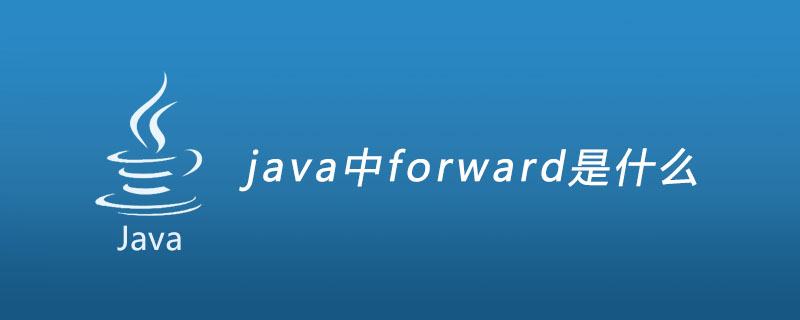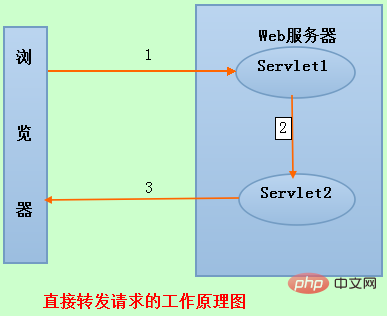What is forward in java
In java, forward refers to "direct forwarding method". For the direct method, the client browser only issues a request. The Servlet forwards the request to Servlet, HTML, JSP or other information resources. The second information resource responds to the request. In the request object request, the saved object is for each Information resources are shared.

The user sends an HTTP request to the server. The request may be processed by multiple information resources before being returned to the user. Each information resource uses a request forwarding mechanism. Requests are forwarded to each other, but users do not feel that the requests are forwarded. Depending on the forwarding method, it can be divided into direct request forwarding (Forward) and indirect request forwarding (Redirect).
Direct forwarding method (Forward), the client and browser only issue one request. Servlet, HTML, JSP or other information resources, the second information resource responds to the request, and saves it in the request object request. The objects are shared with each information resource.
The indirect forwarding method (Redirect) is actually two HTTP requests. When the server responds to the first request, it allows the browser to send a request to another URL to achieve the purpose of forwarding.
To give a popular example:
Direct forwarding is equivalent to: "A asked B to borrow money, B said he didn't have it, B went to C to borrow it, and if he couldn't borrow it, he would pass the message on. To A";
Indirect forwarding is equivalent to: "A asked B to borrow money, but B said he didn't have it, so he asked A to borrow money from C."
Detailed explanation of the direct forwarding method (Forward)
The direct forwarding method is used more often. Generally speaking, request forwarding refers to the direct forwarding method. Most web applications will have a controller. It is up to the controller to control which information resource the request should be forwarded to. Then these information resources process the request, and after processing, it may be forwarded to other information resources to return to the user. This process is the classic MVC model.
javax.serlvet.RequestDispatcher interface is an interface that the request forwarder must implement. The Web container provides the Servlet with an object that implements this interface. The purpose of request forwarding is achieved by calling the forward() method of the interface. Example code As follows:
......
//Servlet里处理get请求的方法
public void doGet(HttpServletRequest request , HttpServletResponse response){
//获取请求转发器对象,该转发器的指向通过getRequestDisPatcher()的参数设置
RequestDispatcher requestDispatcher =request.getRequestDispatcher("资源的URL");
//调用forward()方法,转发请求
requestDispatcher.forward(request,response);
}......
The process of directly forwarding the request shown in the above figure is as follows:
The browser issues an access request to Servlet1;
Servlet1 calls the forward() method and forwards the request to Servlet2 on the server side;
Eventually Servlet2 responds.
Tips: In fact, through the browser, you can observe the request forwarding method used by the server. When a hyperlink is clicked, the current address bar will appear in the browser's address bar. The requested address. If after the server-side response is completed, it is found that the address in the address bar has changed, it proves that the request is forwarded indirectly. On the contrary, if the address does not change, it means a direct request for forwarding or no forwarding.
Extended information:
What are the principles and differences between direct forwarding and indirect forwarding?
Answer: Forward and Redirect represent two request forwarding methods: direct forwarding and indirect forwarding. Corresponding to the code, they are the forward() method of the RequestDispatcher class and the sendRedirect() method of the HttpServletRequest class.
For the indirect method, when the server responds to the first request, it allows the browser to send a request to another URL to achieve the purpose of forwarding. It is essentially two HTTP requests, corresponding to two request objects.
For the direct method, the client browser only issues one request, and the Servlet forwards the request to Servlet, HTML, JSP or other information resources. The second information resource responds to the request. The two information resources share the same A request object.
The above is the detailed content of What is forward in java. For more information, please follow other related articles on the PHP Chinese website!

Hot AI Tools

Undresser.AI Undress
AI-powered app for creating realistic nude photos

AI Clothes Remover
Online AI tool for removing clothes from photos.

Undress AI Tool
Undress images for free

Clothoff.io
AI clothes remover

Video Face Swap
Swap faces in any video effortlessly with our completely free AI face swap tool!

Hot Article

Hot Tools

Notepad++7.3.1
Easy-to-use and free code editor

SublimeText3 Chinese version
Chinese version, very easy to use

Zend Studio 13.0.1
Powerful PHP integrated development environment

Dreamweaver CS6
Visual web development tools

SublimeText3 Mac version
God-level code editing software (SublimeText3)

Hot Topics
 Java Spring Interview Questions
Aug 30, 2024 pm 04:29 PM
Java Spring Interview Questions
Aug 30, 2024 pm 04:29 PM
In this article, we have kept the most asked Java Spring Interview Questions with their detailed answers. So that you can crack the interview.
 Break or return from Java 8 stream forEach?
Feb 07, 2025 pm 12:09 PM
Break or return from Java 8 stream forEach?
Feb 07, 2025 pm 12:09 PM
Java 8 introduces the Stream API, providing a powerful and expressive way to process data collections. However, a common question when using Stream is: How to break or return from a forEach operation? Traditional loops allow for early interruption or return, but Stream's forEach method does not directly support this method. This article will explain the reasons and explore alternative methods for implementing premature termination in Stream processing systems. Further reading: Java Stream API improvements Understand Stream forEach The forEach method is a terminal operation that performs one operation on each element in the Stream. Its design intention is
 TimeStamp to Date in Java
Aug 30, 2024 pm 04:28 PM
TimeStamp to Date in Java
Aug 30, 2024 pm 04:28 PM
Guide to TimeStamp to Date in Java. Here we also discuss the introduction and how to convert timestamp to date in java along with examples.
 PHP: A Key Language for Web Development
Apr 13, 2025 am 12:08 AM
PHP: A Key Language for Web Development
Apr 13, 2025 am 12:08 AM
PHP is a scripting language widely used on the server side, especially suitable for web development. 1.PHP can embed HTML, process HTTP requests and responses, and supports a variety of databases. 2.PHP is used to generate dynamic web content, process form data, access databases, etc., with strong community support and open source resources. 3. PHP is an interpreted language, and the execution process includes lexical analysis, grammatical analysis, compilation and execution. 4.PHP can be combined with MySQL for advanced applications such as user registration systems. 5. When debugging PHP, you can use functions such as error_reporting() and var_dump(). 6. Optimize PHP code to use caching mechanisms, optimize database queries and use built-in functions. 7
 Java Program to Find the Volume of Capsule
Feb 07, 2025 am 11:37 AM
Java Program to Find the Volume of Capsule
Feb 07, 2025 am 11:37 AM
Capsules are three-dimensional geometric figures, composed of a cylinder and a hemisphere at both ends. The volume of the capsule can be calculated by adding the volume of the cylinder and the volume of the hemisphere at both ends. This tutorial will discuss how to calculate the volume of a given capsule in Java using different methods. Capsule volume formula The formula for capsule volume is as follows: Capsule volume = Cylindrical volume Volume Two hemisphere volume in, r: The radius of the hemisphere. h: The height of the cylinder (excluding the hemisphere). Example 1 enter Radius = 5 units Height = 10 units Output Volume = 1570.8 cubic units explain Calculate volume using formula: Volume = π × r2 × h (4
 PHP vs. Python: Understanding the Differences
Apr 11, 2025 am 12:15 AM
PHP vs. Python: Understanding the Differences
Apr 11, 2025 am 12:15 AM
PHP and Python each have their own advantages, and the choice should be based on project requirements. 1.PHP is suitable for web development, with simple syntax and high execution efficiency. 2. Python is suitable for data science and machine learning, with concise syntax and rich libraries.
 Create the Future: Java Programming for Absolute Beginners
Oct 13, 2024 pm 01:32 PM
Create the Future: Java Programming for Absolute Beginners
Oct 13, 2024 pm 01:32 PM
Java is a popular programming language that can be learned by both beginners and experienced developers. This tutorial starts with basic concepts and progresses through advanced topics. After installing the Java Development Kit, you can practice programming by creating a simple "Hello, World!" program. After you understand the code, use the command prompt to compile and run the program, and "Hello, World!" will be output on the console. Learning Java starts your programming journey, and as your mastery deepens, you can create more complex applications.
 How to Run Your First Spring Boot Application in Spring Tool Suite?
Feb 07, 2025 pm 12:11 PM
How to Run Your First Spring Boot Application in Spring Tool Suite?
Feb 07, 2025 pm 12:11 PM
Spring Boot simplifies the creation of robust, scalable, and production-ready Java applications, revolutionizing Java development. Its "convention over configuration" approach, inherent to the Spring ecosystem, minimizes manual setup, allo






